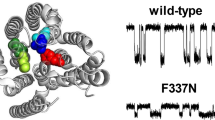Restoration of chloride conductance via introduction of an anion-selective pore, formed by a channel-forming peptide, has been hypothesized as a novel treatment modality for patients with cystic fibrosis. Delivery of these peptides from an aqueous environment in the absence of organic solvents is paramount. M2GlyR peptides, designed based on the glycine receptor, insert into lipid bilayers and polarized epithelial cells and assemble spontaneously into chloride-conducting pores. Addition of 4 lysine residues to either terminus increases the solubility of M2GlyR peptides. Both orientations of the helix within the membrane form an anion-selective pore, however, differences in solubility, associations and channel-forming activity are observed. To determine how the positioning of the lysine residues affects these properties, structural characteristics of the lysyl-modified peptides were explored utilizing chemical cross-linking, NMR and molecular modeling. Initial model structures of the a-helical peptides predict that lysine residues at the COOH-terminus form a capping structure by folding back to form hydrogen bonds with backbone carbonyl groups and hydroxyl side chains of residues in the helical segment of the peptide. In contrast, lysine residues at the NH2-terminus form fewer H-bonds and extend away from the helical backbone. Results from NMR and chemical cross-linking support the model structures. The C-cap formed by H-bonding of lysine residues is likely to account for the different biophysical properties observed between NH2- and COOH-terminal-modified M2GlyR peptides.
Similar content being viewed by others

Author information
Authors and Affiliations
Rights and permissions
About this article
Cite this article
Broughman, J., Shank, L., Prakash, O. et al. Structural Implications of Placing Cationic Residues at either the NH2- or COOH-Terminus in a Pore-forming Synthetic Peptide . J. Membrane Biol. 190, 93–103 (2002). https://doi.org/10.1007/s00232-002-1027-3
Received:
Issue Date:
DOI: https://doi.org/10.1007/s00232-002-1027-3



